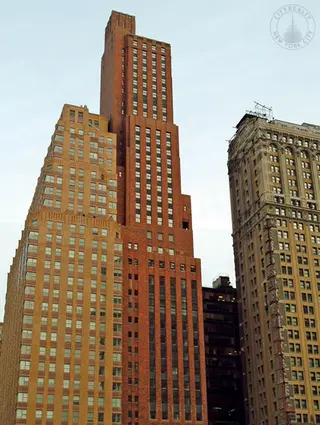 Carter Horsley
Carter HorsleyDec 23, 2011
Carter's Review
The former Downtown Athletic Club building at 20 West Street across from Battery Park City was converted to 288 condominiums in 2006 by The Moinian Group that originally had planned to convert the units to rentals.
The 35-story development is known now as The Downtown Club.
The Art Deco-style building, which is also known as 19 West Street and 28-32 Washington Street, was designated as an official New York City landmark November 14, 2000.
The 534-foot-high Art Deco-style building also fronts on Western Union International Plaza where it overlooks the entrance to the Brooklyn Battery Tunnel.
It was designed by Starrett & Van Vleck, the same firm that designed the adjacent tower at 21 West Street, and had designed the Lord & Taylor Building in 1914, the Saks Fifth Avenue department store in 1922-4, and a major expansion of Bloomingdales in 1930.
When the Downtown Athletic Club opened in 1930, it had 143 "sleeping rooms," seven banquet rooms, an Olympic-sized swimming pool on the 12th floor that was when created reportedly the "highest elevated aquatics facility in the world," billiard rooms, bowling alleys, and squash, handball and racquetball courts.
The club had been home of the Heisman Memorial Trophy, given every year to the most outstanding college football player and named after John Heisman, the club's first athletic director who had previously been coach of Georgia Tech's "Golden Tornado" football team. The prize originated in 1935 when it was named for the club but it was renamed the next year when Heisman died.
The Downtown Athletic Club was founded in 1926 and was initially located at in the Singer Building at 149 Broadway.
Two years later, the club had about 1,000 members and planned a 44-story building that would feature, among other things, a full, 18-hole golf course.
The landmarks commission's report on the building observed that the first published design showed "a classically-detailed, pyramid-topped tower similar to other early work by the firm," adding that "Less than a year later, the building had been scaled back to 35 stories and took the simplified, modernistic form of the existing building."
In 1936, the club filed for bankruptcy and lost control of its building to the General Realty and Utilities Corporation. It was sold in 1947 and repurchased in 1950. In 1977, the membership voted to admit women.
In 1999, the building was acquired by the Cheslock Bakker Opportunity Fund and sold back the lower floors to the club.
The building is faced in mottled orange brick and the excellent masonry can be seen in the corbelling around its entrances, the window recesses and the open work of the roof parapets that create, according to the landmarks commission "an elegant yet subtle design."
The building is set back from the building line on both its east and west façades and the tower rises in a series of irregular setbacks that one observer suggested was a precursor to the form of the Sears Tower in Chicago.
The apartments range in size from about 500 sq. ft. to about 1,000 sq. ft. with prices starting initially at about $475,000. The loft-style apartments at the top of the building have 9- to 16-foot-high ceilings and open-island kitchens. The building has a 12,000-sq.ft. sports and gym facility with spa services and an owners' lounge that is be known as the Trophy Club.
In its landmark designation of the building, the Landmarks Preservation Commission noted that "The boxy shape and variety of setbacks in the...building demonstrate the effects of the 1916 Building Zone Resolution, but also give some indication of the various purposes assigned to different sections of the building."
"The architects juxtaposed the simple massing of the building with stylized, theater-like entrance prosceniums on both façades and a dextrous use of flat and angled brick, creating a dramatic addition to the city's skyline. The powerful chevron motifs in the rectangular areas over the entrances and in the spandrels between the windows of the upper stories are a variation of a common design theme of the period, reflective of the speed and energy of the Jazz Age."
When terrorists attacked the World Trade Center on September 11, 2001, the upper floors of the mid-block tower were being gutted and their windows were open.
The 2001 Heisman Trophy ceremony was moved to the Marriott Marquis in Times Square and in 2002 and 2003 it was held at The Yale Club.
Architect Goldwin Starrett was one of the principal assistants at D. H. Burnham & Co., before joined his brother Theodore in 1898 at the New York firm of George A. Fuller Construction Company. Three years later, he and Theodore were joined by their brothers Ralph and William A. and formed the Thompson-Starrett Construction Company and Goodwin Starrett was the architect for the Alquonquin Hotel in 1902. In 1907, Ernest Allen Van Vleck joined and the firm became known as Starrett & Van Vleck.
Entrances on both West and Washington Streets have step-up entrances and marquees.
Avinash K. Malhotra was the architect for the residential conversion.

- Condo built in 1930
- Converted in 2006
- 4 apartments currently for sale ($499K to $599K)
- 2 apartments currently for rent ($6K)
- Located in Financial District
- 288 total apartments 288 total apartments
- 10 recent sales ($415K to $999K)
- Doorman
- Pets Allowed
 6sqft delivers the latest on real estate, architecture, and design, straight from New York City.
6sqft delivers the latest on real estate, architecture, and design, straight from New York City.
